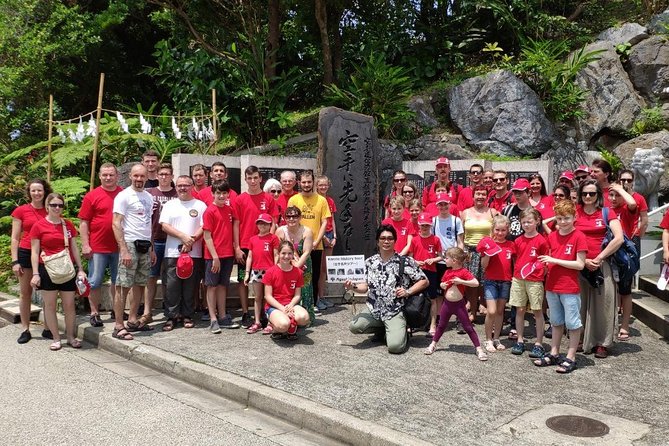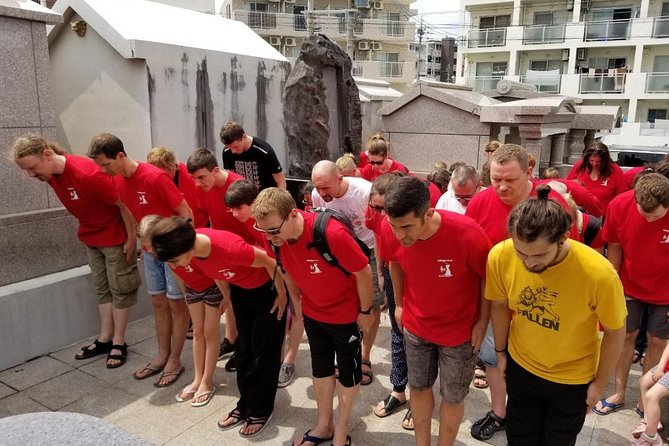Set out on a captivating journey through time on the Karate History Tour in Okinawa. Led by knowledgeable guides, you will explore the birthplace of karate, seeing the ancient roots and traditions of this martial art.
From ancient training grounds to sacred temples, each location holds a piece of the karate legacy. Engaging storytelling and interactive demonstrations will bring the history to life, providing a profound understanding of the cultural significance of karate in Okinawa.
Brace yourself for an enlightening and unforgettable adventure.
Good To Know

- Chinese martial arts played a significant role in the origins and development of Karate in Okinawa.
- Okinawa is home to famous karate dojos and historical sites like Shuri Castle and Okinawa Prefectural Budokan.
- Traditional karate training methods involve rigorous physical conditioning, disciplined techniques, and the practice of kihon, kata, and kumite.
- Okinawa has been a melting pot of different martial arts traditions, leading to the evolution of diverse karate styles with unique characteristics.
Origins of Karate in Okinawa

One of the key factors in understanding the origins of Karate in Okinawa is the influence of Chinese martial arts.
The cultural significance of Karate in Okinawa can’t be overstated, as it has had a profound influence on martial arts worldwide.
Karate, which means ’empty hand,’ developed in Okinawa as a form of self-defense when weapons were banned by the ruling class.
The Okinawan people adapted and incorporated various techniques from Chinese martial arts, such as kung fu, to create their own unique fighting style.
These techniques were refined over time, resulting in the development of Karate as we know it today.
The influence of Chinese martial arts on the origins of Karate hasn’t only shaped its techniques and principles but has also contributed to its global recognition and popularity.
Interested in history? More Naha historical sites we've covered
Influential Figures in Okinawan Karate
An exploration of the influential figures in Okinawan Karate reveals the profound impact they’ve had on the development and evolution of this martial art.
Okinawa is home to many famous karate dojos, where these influential figures have trained and honed their skills. These dojos serve as important hubs for learning and promoting the art of karate.
Plus, Okinawa hosts several karate tournaments throughout the year, attracting practitioners from all over the world. These tournaments provide an opportunity for karate enthusiasts to showcase their skills and compete against the best in the field.
The involvement of influential figures in these tournaments not only adds prestige but also inspires the next generation of karate practitioners. Through their teachings and participation in karate events, these influential figures continue to shape and enrich the world of Okinawan Karate.
Historical Sites and Landmarks
The exploration of influential figures in Okinawan Karate naturally leads to a discussion on the historical sites and landmarks that have played a significant role in shaping this martial art. Okinawa, known as the birthplace of karate, is home to numerous sites that hold great historical value.
One such landmark is the Shuri Castle, a UNESCO World Heritage site, which served as the royal palace of the Ryukyu Kingdom. It was here that the Okinawan karate techniques were refined and developed.
Another important site is the Okinawa Prefectural Budokan, a modern martial arts facility that pays homage to the rich karate history in Japan. Visitors can witness demonstrations, participate in training sessions, and gain a deeper understanding of the roots and evolution of this ancient martial art.
Exploring these historical sites and landmarks isn’t just a journey through time, but also a way to appreciate the resilience and spirit of the Okinawan people.
Traditional Karate Training Methods
Traditional karate training methods involve rigorous physical conditioning and disciplined techniques that have been passed down through generations. These techniques are deeply rooted in Okinawan martial arts culture and are designed to develop not only physical strength and agility, but also mental focus and discipline.
One of the key aspects of traditional karate training is kihon, which refers to the basic techniques and movements. Practitioners spend countless hours perfecting punches, kicks, blocks, and stances, ensuring that each movement is executed with precision and power.
Another important training method is kata, which are predetermined sequences of movements that simulate combat situations. Karateka practice these kata repeatedly, aiming to master the techniques and internalize the principles of timing, distance, and body mechanics.
Sparring, known as kumite, is also an integral part of karate training. This allows practitioners to apply their techniques in a controlled environment, testing their skills against a partner.
Evolution of Karate Styles in Okinawa
Karate styles in Okinawa have evolved over time, reflecting the rich history and cultural influences of the region. As the birthplace of karate, Okinawa has been a melting pot of different martial arts traditions. Over the years, various styles have emerged, each with its unique techniques and philosophies.
One significant factor that contributed to the evolution of karate styles in Okinawa is the introduction of karate tournaments. These competitions provided an opportunity for practitioners to test their skills and showcase their techniques. As a result, karate styles adapted and developed strategies specifically suited for tournament settings, emphasizing speed, efficiency, and precision.
On top of that, the exchange of knowledge between different masters and practitioners from various regions also played a crucial role in the evolution of karate styles. This cross-pollination of ideas and techniques led to the refinement and innovation of existing styles.
Today, Okinawa is home to a diverse range of karate styles, each with its unique characteristics and approaches. From the traditional and disciplined Shorin-ryu to the dynamic and explosive Goju-ryu, Okinawa continues to be a hub for karate enthusiasts seeking to explore the rich tapestry of karate techniques.
- 2-Hour Private Gorilla Go Kart Experience in Okinawa
- Go-Kart Tour on Public Roads Visiting Many Landmarks
- Shuri,Naha:Cycling Tour Exploring Water Heritage With E-Bike
- Okinawa Hot Spot Walk and Local Food & Beer Tour(All Include)
- Naha To/From Nago or Motobu Area Private Transfer
- Private Transfer From Naha City Hotels to Nakagusuku Cruise Port
Okinawan Karate in Modern Times
In modern times, practitioners of Okinawan karate have embraced contemporary training methods and incorporated them into their practice. With the advancement of martial arts, modern karate techniques have been developed to enhance speed, power, and precision. These techniques focus on practical self-defense applications and efficient movements.
The impact of karate on Okinawan culture can’t be understated. It has become a symbol of national pride and identity, with Okinawa being recognized as the birthplace of karate. Karate schools and dojos are found throughout the island, offering training to both locals and visitors.
The practice of karate promotes discipline, respect, and physical fitness, and it continues to be an integral part of Okinawan culture in the present day.
Famous Okinawan Karate Practitioners
Renowned martial artists who’ve honed their skills in Okinawa include notable Okinawan Karate practitioners. Okinawa has been home to many famous karate tournaments, attracting talented fighters from around the world. These tournaments have showcased the skills and techniques of karate legends, who’ve left a lasting impact on the martial arts community.
One such legend is Chojun Miyagi, the founder of Goju-Ryu Karate. Miyagi’s emphasis on strength and fluidity in his techniques has made him a revered figure in the karate world.
Another prominent figure is Gichin Funakoshi, who introduced Shotokan Karate to mainland Japan. His disciplined approach and emphasis on kata training have greatly influenced the development of modern karate.
These karate practitioners haven’t only achieved fame but have also inspired generations of martial artists with their dedication and skill.
Preserving the Legacy of Okinawan Karate
To ensure the continued preservation of Okinawan Karate’s legacy, efforts are being made to safeguard its teachings and traditions. The preservation efforts focus on maintaining the cultural significance of Okinawan Karate and passing it down to future generations. Here are five ways in which the legacy of Okinawan Karate is being preserved:
Documentation and Research: Scholars and experts are conducting extensive research to document the history, techniques, and philosophies of Okinawan Karate.
Training and Education: Dedicated instructors and dojos are committed to teaching the authentic techniques and principles of Okinawan Karate.
Cultural Exchange Programs: Okinawan Karate practitioners from around the world visit Okinawa to enjoy the rich culture and learn from local masters.
Preservation of Traditional Dojos: Traditional dojos, where Okinawan Karate was first practiced, are being preserved to maintain the original training environment and atmosphere.
Promotion of Okinawan Karate: Exhibitions, tournaments, and seminars are organized to raise awareness about the cultural significance of Okinawan Karate and attract new practitioners.
Through these preservation efforts, the legacy of Okinawan Karate remains alive, ensuring that its teachings and traditions continue to inspire and educate future generations.
Common Questions
How Long Is the Karate History Tour in Okinawa?
The length of the karate history tour in Okinawa varies depending on the specific tour package chosen. Duration can range from a few hours to a full day, allowing participants to fully enjoy the rich history of karate.
Are There Any Age Restrictions for the Tour?
Age restrictions for the tour vary depending on the specific tour operator. It is recommended to check with the tour provider for any age restrictions. The tour duration typically lasts for several hours.
Is Transportation Provided From the Hotel to the Tour Location?
Yes, transportation is provided from the hotel to the tour location. Guests can enjoy a hassle-free experience as they are conveniently picked up from their hotel and taken to the starting point of the tour.
Can Beginners Participate in the Tour, or Is It Only for Experienced Karate Practitioners?
Beginners are welcome on the tour, as it is designed to be accessible for all skill levels. Whether you’re a novice or an experienced practitioner, you can join in and learn about the rich history of karate in Okinawa.
Are There Any Additional Fees or Costs Not Included in the Tour Price?
Additional expenses or costs not included in the tour price may vary depending on the specific tour. It is recommended to check the tour details or contact the tour provider for clarification on any potential additional fees.
The Sum Up
As the Karate History Tour in Okinawa comes to a close, participants are left with a profound sense of awe and admiration for this ancient martial art.
From exploring the origins of karate to witnessing the evolution of different styles, this immersive experience has provided a captivating journey through time.
The tour hasn’t only deepened our understanding of the cultural significance of karate but also highlighted the importance of preserving its legacy for future generations.
More Historical Tours in Naha
More Tours in Naha
More Tour Reviews in Naha
- Okinawa Blue Zone 4 Days Discovery Adventure in UNESCO Site
- Kerama Tokashiki Island and Whale Watching Tour
- Orca Glass Bottom Boat With Sam’S Steak Lunch Set Plan
- 1-Hour Go-Kart Adventure on Public Roads in Okinawa IDP Needed
- Okinawa E-bike Rental (Sporty Type)
- Double-Decker Open Top Bus Okinawa to Umikaji Terrace
Looking for something different? Other Naha activities we've written about
- Okinawa Blue Zone 4 Days Discovery Adventure in UNESCO Site
- Kerama Tokashiki Island and Whale Watching Tour
- Orca Glass Bottom Boat With Sam’S Steak Lunch Set Plan
- 1-Hour Go-Kart Adventure on Public Roads in Okinawa IDP Needed
- Okinawa E-bike Rental (Sporty Type)
- Double-Decker Open Top Bus Okinawa to Umikaji Terrace
- Okinawa Day Tour to the Top Sightseeing Spots
- Private Tour: Afternoon Cycling With Spectacular Views
- Snorkeling in Tokashiki From Tomari Port by High Speedboat
- 2-Day Electric Scooter Rental in Okinawa
- Phantom Cafe Tour in the Shuri by E-Bike
- Tokashiki Island Day Tour and Snorkeling Kerama Blue
